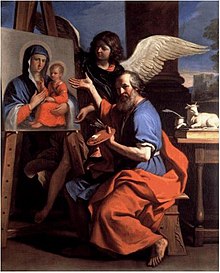Accademia di San Luca
 St. Luke Displaying a Painting of the Virgin by Guercino | |
| Named after | St. Luke |
|---|---|
| Formation | 1577 |
| Founded at | Rome |
| Type | Association of artists |
| Purpose | Elevating the work of "artists" |
| Leader | Federico Zuccari |
| Secessions | Accademia Nazionale di San Luca |
Formerly called | Compagnia di San Luca |
The Accademia di San Luca, (the "Academy of Saint Luke") was founded in 1577 as an association of artists in Rome (under the directorship of Federico Zuccari from 1593[1]), with the purpose of elevating the work of "artists", which included painters, sculptors and architects, above that of mere craftsmen. Other founders included Girolamo Muziano and Pietro Olivieri. The Academy was named after Saint Luke the evangelist who, legend has it, made a portrait of the Virgin Mary, and thus became the patron saint of painters' guilds.
From the late 16th century until it moved to its present location at the Palazzo Carpegna, it was based in an urban block by the Roman Forum and although these buildings no longer survive, the Academy church of Santi Luca e Martina, does. Designed by the Baroque architect, Pietro da Cortona, its main facade overlooks the Forum.
History
The Academy's predecessor was the Compagnia di San Luca, a guild of painters and miniaturists, which had its statutes and privileges renewed at the much earlier date of 17 December 1478 by Pope Sixtus IV. Included among its founding members, was the famous painter Melozzo da Forlì, as he was the pictor papalis in that period.
In 1605, Pope Paul V granted the Academy the right to pardon a condemned man on the feast of St. Luke. In the 1620s, Urban VIII extended its rights to decide who was considered an artist in Rome and it came under the patronage of his nephew, Cardinal Francesco Barberini. In 1633, Urban VIII gave it the right to tax all artists as well as art-dealers, and monopolize all public commissions. These latter measures raised strong opposition and apparently were poorly enforced.[2]
Over the early years, the papal authorities exerted a large degree of control over the leadership of the institution. Some modern critics have stated "with the ostensible purpose of giving artists a higher education and the real one of asserting the Church's control over art,".[3]
The prìncipi (directors) of the institution have included some of the pre-eminent painters of the 17th century, including Domenichino, Bernini, Cortona and Romanelli. However, many prominent artists never joined or were admitted to the academy.
The Cortona-Sacchi Debate and other artistic issues
Artistic issues debated within the Academy included the Cortona-Sacchi controversy (see Andrea Sacchifor further details of this debate) about the number of figures in a painting. Disdain was espressed by many academicians for the Bamboccianti.[4]
Giovanni Bellori gave famous lectures on painting in the Academy. In the early 18th century, the painter Marco Benefial was inducted, and then expelled for criticizing the academy as an insider.
Recent times
The Academy is still active; the Accademia Nazionale di San Luca is its modern descendant. From the very beginning, the statutes of the Academy directed that each candidate-academician was to donate a work of his art in perpetual memory and, later, a portrait. Thus the Academy, in its current premises in the 16th-century Palazzo Carpegna, located in the Piazza dell'Accademia di San Luca, has accumulated a unique collection of paintings and sculptures, including about 500 portraits, as well as an outstanding collection of drawings.
Principi
Prominent artists to become Principi of the academy over the first 200 years include:
Claude Lorrain was a member but declined the offer of being principi. The Academy can also boast modern members, including sculptors Ernesto Biondi and Piccirilli Brothers.
External links
- Accademia Nazionale di San Luca Official site (in Italian)
- Galleria Nazionale di San Luca (in Italian)
- Accademia San Luca (in Italian)
- The History of the Accademia di San Luca, c. 1590-1635: Documents from the Archivio di Stato di Roma (in English and Italian)
References
- Haskell, Francis (1993). "Ch 8". Patrons and Painters: Art and Society in Baroque Italy. 1980. Yale University Press. pp. 17–18.
- ^ Goldstein, Carl – Teaching Art: Academies and Schools from Vasari to Albers. Cambridge; New York: Cambridge University Press, 1996, p. 30. ISBN 0-521-55988-X
- ^ Haskell, p 18.
- ^ according to Peter Robb, biographer of the Baroque artist Caravaggio
- ^ [1]
